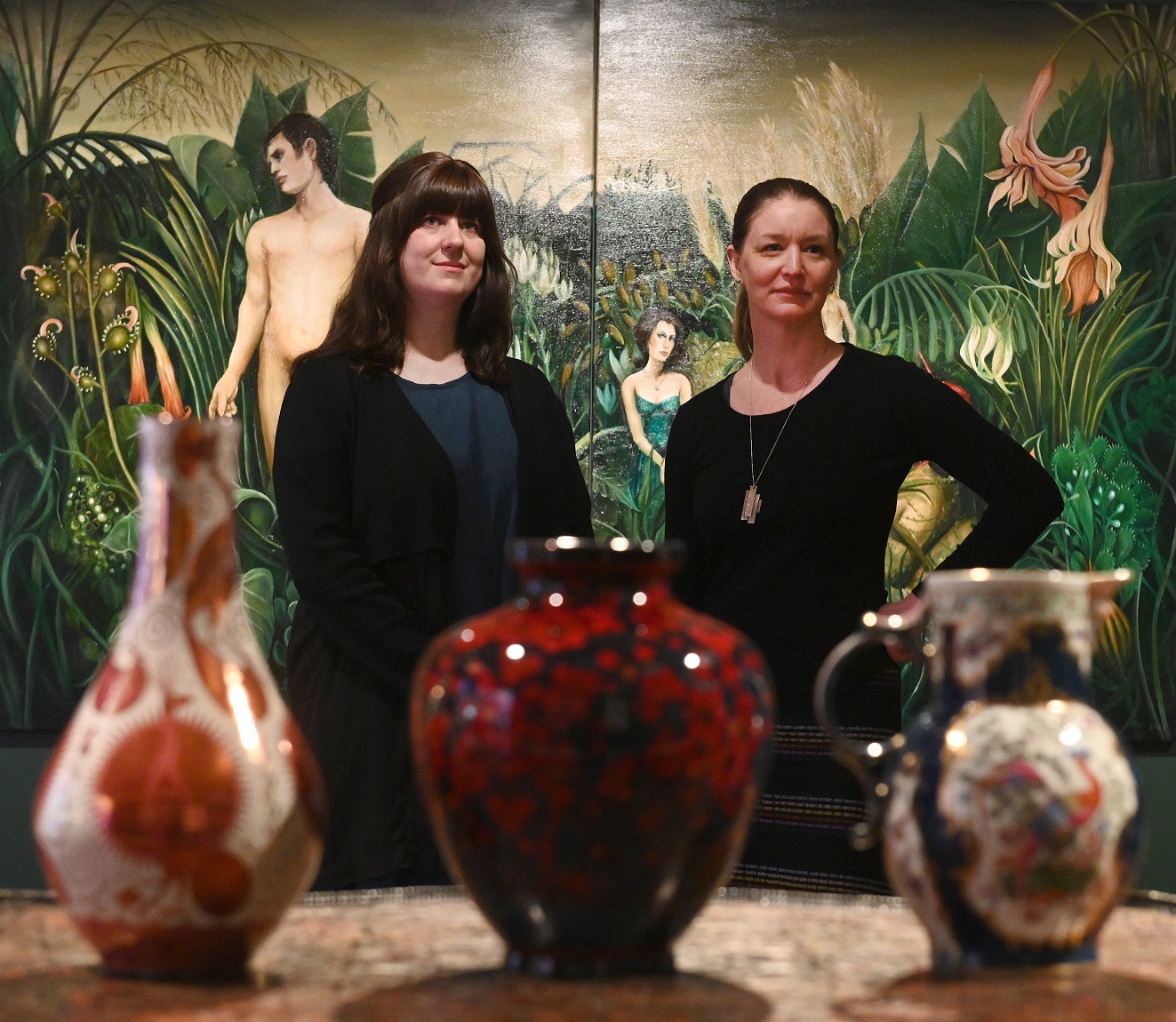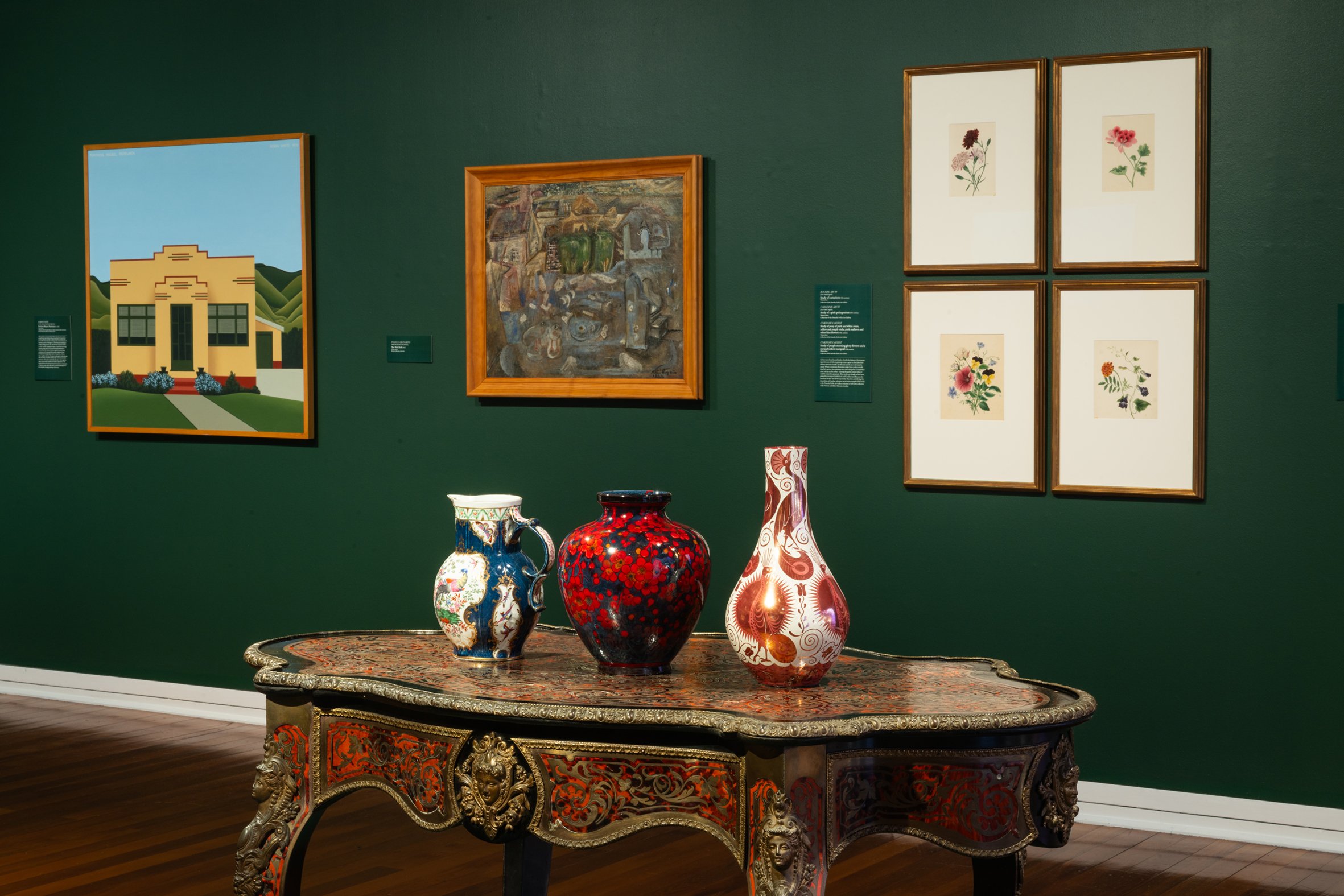
Withering sunflowers, wrinkly potatoes, squawking chickens, blooming flowers — the many different cycles of growth and decay in nature are captured by artists in many different ways.
This is highlighted in a new exhibition at the Dunedin Public Art Gallery, "Rewilding", which draws from the collection a range of different works — video, sculpture, painting, decorative arts and drawing — exploring how artists have thought over centuries about gardening, cultivation, wilderness and what happens when nature prevails.
"It’s a playful way to think about the way artists have come to those subject matters in their works," curator Lucy Hammonds says.
"Because the natural world is an enduring and constant topic or subject of creative practice."
It enabled Hammonds and fellow curator Lauren Gutsell to do a deep dive into the DPAG’s collection, testing and exploring where that research thread could lead them.
"We became sort of captivated by the unexpected sort of tangents that can take you on," Hammonds says.
"Because, whilst you know that subjects like gardens and picturesque floral patterns and the cultivated space of nature is a very popular subject for artists particularly in a historic sense, it was the works which sort of stepped outside of that and into the kind of wild and wonderful cycles of seasons and unexpected encounters with the natural world, and where that could take you, that actually came up as a really prevailing theme."
So the exhibition took a double path along the idea that while you can cultivate a garden and shape it to your wants and desires, ultimately nature will always take over.
That led to the notion of rewilding, an ecological restoration movement which is based on leaving gardens and green spaces to nature.
"It’s quite a kind of, I suppose, a hot topic in contemporary conservation practices right now."
They also discovered some of the works in the collection provided a view into how artists have thought about ideas of regeneration or a dystopian future where humans lose control over time.

"It felt like quite a rich area to explore. And obviously this is a small sort of snapshot into that theme — there was a lot of work that could have ended up in this space."
As it is their selection of works spans from the late 1700s through to 2023 and features works that have not been seen for a long time alongside more recently shown works.
"It’s also a massive time period but has that point of connection with how gardens and plants and a human relationship to those things have existed in artworks."
Hammonds says looking across the collection they could also see ideas of season change and decay present in different artists’ work.
"For instance, there’s a very beautiful painting of Philip Trusttum, [Dead Sunflowers, c.1973] of, you know, a group of sunflowers past their peak, just starting to kind of wither off and die off."
Then there is the "hilarious" sculpture Last Year (2008) by Ronnie van Hout of two sets of potatoes, six ripe potatoes aside wrinkly casts of the same potatoes gone to seed.
"They give you a very kind of clear contrast of that process of time passing and of decay. So that’s been quite a fun way to think about the works or to see in the works that kind of constant sort of interest in returning or tracking cycles of growth and decay. It ended up being a bigger part of the exhibition than what we initially had thought."
Then there are two sets of traditional botanical illustrations. While undated, one is believed to be from the 19th century and the other the 20th century.
"There’s one that is looking very much at the flower and the other ones are sort of looking at the garden and the plants are full of pollinators, the seed heads are sort of just foaming and it captures a totally different sense of the plant."
Examples of historic decorative arts in the collection such as a Boulle-style table and British pottery (Worcester Porcelain, William De Morgan Pottery and Doulton & Co) highlight the ways in which decorative and applied arts could carry forms, motifs, and materials from nature into the home which contrast with the pieces by New Zealand studio ceramicists from the ’60s and ’70s and now.
They are "really looking at clay and ceramic practices as materials that are sort of alchemistic of the earth and about sort of changing things through fire and heat and really thinking hard about the origins of those things".

"It also has that real magical sort of sense of how many people move through nature and sort of collect discarded items like stones and sticks and bones and bird shells and egg shells and birds’ nests and you know carry them home."
She believes there are some "mysterious and interesting" moments throughout the exhibition such as Robin White, Fortress House, Paremata (Nov 1980), which is part of a whole series of works looking at the transformation of the landscape of Aotearoa from something that was loose, wild and forested in the early 20th century to one which is deforested and open for housing development with manicured gardens.
"All the kind of complexities that come with thinking through those social and political histories are carried within looking at a painting like that and thinking about what its origins are and what the artist is looking at literally as they are thinking about their composition. You know which is a moment of great progress, great social progress but also you know a radical transformation and change of the landscape which is sort of irrevocable at the same time."
It also shows how putting different works together in different ways can take people on a totally different journey than they might have had before with a work.
"I think that’s the amazing thing about our artworks."
Gutsell says another example of that is Looking at things as a whole #6 (2023) by Kate Fitzharris, which was shown in an exhibition last year and was acquired by the gallery.
It was the first of her works to enter the DPAG collection.
"So it’s great in this exhibition to be able to bring that work out on display again but in a totally different context where it sits in conversation with work by Len Castle and Barry Brickell — two works made in the mid-’60s and this work from 2023."
"And so that’s always a great thing to see how those things respond together and what sort of nuances come from similarities and differences and the label of this work brings together three quotes from each of the artists."
Pulling together the exhibition also gave the curators an opportunity to discover more about the artists and works in the collection.
"It’s always nice to have the opportunity to do that sort of research, even if it’s not at an incredibly deep level, but it always brings up things that we didn’t know or sort of think about differently. And then that adds to the collection research that sits with the works."

"It was interesting to kind of put together that while the site of that work is unnamed. You can kind of make a connection to that point in the artist’s life, what was happening for him and his family at that time here in this city, and how that possibly could be reflected."
Then John Frederick Lewis’ The Bouquet (1857) was influenced by his time living in Cairo, Egypt in the 1840s and 1850s.
She discovered looking at his work across time that the same woman turns up in his works again and again wearing a similar green jacket with white trim.
"But just that theme, that sort of return to that motif through the textiles of the woman in the paintings that kind of tracks that period of work from that sort of mid-19th century was interesting."
In total contrast again is Hayden Fowler’s video work, New World Order (2013), which features heritage-breed chickens in an eerie, grey forest scene punctuated by unique bird calls.
Gutsell discovered that prior to filming the work, Fowler had created a diorama for the chickens to move through.
"He wanted them to sort of feel familiar in this environment."
Hammonds says the exhibition also provides an opportunity for the gallery’s conservation team to do any restoration work needed on pieces that may have been in storage for a long time.
"So the exhibition sort of becomes the mechanism for activating those processes to start. Often you’ll find artworks coming out the other side of the exhibition looking refreshed and ready."
TO SEE
"Rewilding", Dunedin Public Art Gallery, September 14 to February 28, 2025; Exhibition tour, curators Lauren Gutsell & Lucy Hammonds, Saturday, September 28, 11am.











